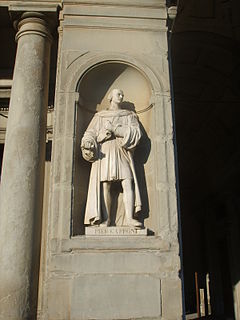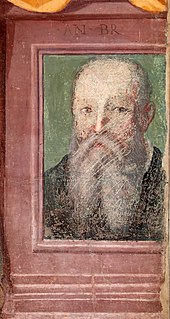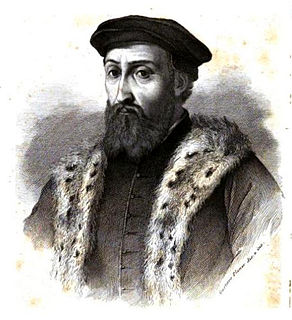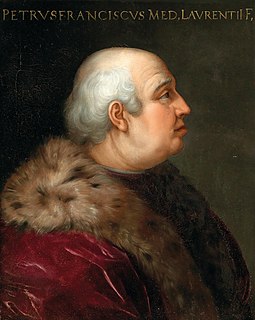Among several members of the extended Florentine patrician family the Cavalcanti [1] holding the name Giovanni, the chronicler Giovanni Cavalcanti (1381-c.1451), [2] of a minor branch of the family but who was captain of the Guelf party in 1422, is most widely remembered for his malevolent and melancholic account [3] of Florence, covering the period 1420-47. Cavalcanti's Storie obsessively focussed on the city's political intrigues and scandals and was colored by his personal political misfortunes as an aristocratic agitator, first against the corrupt oligarchy of 1420-34 and subsequently of the Medici; his long imprisonment for debt excluded him from the participation in public life that he considered his noble right.
Historians had discounted the decayed grande, Cavalcanti, who was rehabilitated by Claudio Varese, 1961. [4] In private he was also the author of a Trattato politico-morale, written in the 1440s and dedicated to the anti-Medicean Neri Capponi; it was intended as a Ciceronian moral guide to family morality and a nostalgic account of lost, pre-Medicean civic virtues, offered with Roman parallels, intended for Neri's young son. [5]

Lorenzo di Piero de' Medici was an Italian statesman, banker, de facto ruler of the Florentine Republic and the most powerful and enthusiastic patron of Renaissance culture in Italy. Also known as Lorenzo the Magnificent by contemporary Florentines, he was a magnate, diplomat, politician and patron of scholars, artists, and poets. As a patron, he is best known for his sponsorship of artists such as Botticelli and Michelangelo. He held the balance of power within the Italic League, an alliance of states that stabilized political conditions on the Italian peninsula for decades, and his life coincided with the mature phase of the Italian Renaissance and the Golden Age of Florence. On the foreign policy front, Lorenzo manifested a clear plan to stem the territorial ambitions of Pope Sixtus IV, in the name of the balance of the Italian League of 1454. For these reasons, Lorenzo was the subject of the Pazzi conspiracy (1478), in which his brother Giuliano was assassinated. The Peace of Lodi of 1454 that he supported among the various Italian states collapsed with his death. He is buried in the Medici Chapel in Florence.

The House of Medici was an Italian banking family and political dynasty that first began to gather prominence under Cosimo de' Medici, in the Republic of Florence during the first half of the 15th century. The family originated in the Mugello region of Tuscany, and prospered gradually until it was able to fund the Medici Bank. This bank was the largest in Europe during the 15th century, and it facilitated the Medicis' rise to political power in Florence, although they officially remained citizens rather than monarchs until the 16th century.

Donato di Niccolò di Betto Bardi, better known as Donatello, was a Florentine sculptor of the Renaissance period. Born in Florence, he studied classical sculpture and used this to develop a complete Renaissance style in sculpture. He spent time in other cities, and while there he worked on commissions and taught others; his periods in Rome, Padua, and Siena introduced to other parts of Italy his techniques, developed in the course of a long and productive career. Financed by Cosimo de' Medici, Donatello's David was the first freestanding nude male sculpture since antiquity.

Cosimo di Giovanni de' Medici was an Italian banker and politician who established the Medici family as effective rulers of Florence during much of the Italian Renaissance. His power derived from his wealth as a banker, and he was a patron of arts, learning and architecture. He spent over 600,000 gold florins on art and culture, including Donatello's David, the first freestanding nude male sculpture since antiquity. Despite his influence, his power was not absolute; Florence's legislative councils at times resisted his proposals throughout his life, and he was viewed as first among equals, rather than an autocrat.

Giovanni di Bicci de' Medici was an Italian banker and founder of the Medici Bank. While other members of the Medici family, such as Chiarissimo di Giambuono de' Medici, who served in the Signoria of Florence in 1201, and Salvestro de' Medici, who was implicated in the Ciompi Revolt of 1378, are of historical interest, it was Giovanni's founding of the family bank that truly initiated the family's rise to power in Florence. He was the father of Cosimo de' Medici and of Lorenzo the Elder; grandfather of Piero di Cosimo de' Medici; great-grandfather of Lorenzo de' Medici ; and the great-great-great-grandfather of Cosimo I de' Medici, Grand Duke of Tuscany.

The Republic of Florence, officially the Florentine Republic, was a medieval and early modern state that was centered on the Italian city of Florence in Tuscany. The republic originated in 1115, when the Florentine people rebelled against the Margraviate of Tuscany upon the death of Matilda of Tuscany, who controlled vast territories that included Florence. The Florentines formed a commune in her successors' place. The republic was ruled by a council known as the Signoria of Florence. The signoria was chosen by the gonfaloniere, who was elected every two months by Florentine guild members.

Piero Capponi was an Italian statesman and warrior from Florence; he is best celebrated for his bold defiance of the King of France in 1494.

Michelozzo di Bartolomeo Michelozzi was an Italian architect and sculptor. Considered one of the great pioneers of architecture during the Renaissance, Michelozzo was a favored Medici architect who was extensively employed by Cosimo de' Medici. He was a pupil of Lorenzo Ghiberti in his early years, and later collaborated with Donatello.

Agnolo di Cosimo, usually known as Bronzino or Agnolo Bronzino, was an Italian Mannerist painter from Florence. His sobriquet, Bronzino, may refer to his relatively dark skin or reddish hair.
Cavalcanti is an Italian surname, used by people of ancient Italian origin. In Italy and Brazil the variant Cavalcante is also used. The family came to Brazil in 1560.

Corsini is the name of a Florentine princely family.

The Medici Bank was a financial institution created by the Medici family in Italy during the 15th century (1397–1494). It was the largest and most respected bank in Europe during its prime. There are some estimates that the Medici family was, for a period of time, the wealthiest family in Europe. Estimating their wealth in today's money is difficult and imprecise, considering that they owned art, land, and gold. With this monetary wealth, the family acquired political power initially in Florence, and later in the wider spheres of Italy and Europe.

San Marco is a religious complex in Florence, Italy. It comprises a church and a convent. The convent, which is now the Museo Nazionale di San Marco, has three claims to fame. During the 15th century it was home to two famous Dominicans, the painter Fra Angelico and the preacher Girolamo Savonarola. Also housed at the convent is a famous collection of manuscripts in a library built by Michelozzo. Furthermore, the church houses the tomb of Pico Della Mirandola, Renaissance philosopher and so called father of humanism.

Filippo Strozzi the Younger was a Florentine banker, and the most famous member of the Strozzi family in the Renaissance. He is best remembered as a tragic hero and defender of the lost Florentine republic against the Medici dukes – yet this is almost entirely a nineteenth-century fiction of nationalist historians and dramatists. He had been one of the staunchest supporters of the House of Medici in Florence and Rome.
Lorenzo the Elder was an Italian banker of the House of Medici of Florence, the younger brother of Cosimo de' Medici the Elder and progenitor of the so-called "Popolani" line of the family, named for a later generation whose members were supporters of the Florentine political activist Girolamo Savonarola.

Pierfrancesco de' Medici the Elder was an Italian nobleman, banker, diplomat, and a member of the House of Medici of Florence.
The Accademia Platonica di Firenze or Platonic Academy of Florence was an informal discussion group which formed around Marsilio Ficino in the Florentine Renaissance of the fifteenth century.

The Villa del Trebbio is a Medici villa in Tuscany, Italy.

The Biblioteca Riccardiana is a library in Florence, Italy. The library is located adjacent to the Palazzo Medici Riccardi. The main facade of Michelozzo's Medici Riccardi palace is on Via Camillo Cavour, while Riccardiana library's main but unimposing entrance and facade is located on Via de' Ginori, parallel and northeast of Cavour. The rear of the Medici palace has a small polygonal private garden, whose north side also has an entrance to the library.

Giovanni di Ser Giovanni, known as Lo Scheggia, or "the Splinter" was an Italian painter, brother of the famous Masaccio.
















